San Gimignano: Top Things to See in Tuscany’s Tower Town
Artsy Traveler contains affiliate links for products and services I personally use and can happily recommend. As an Amazon Associate, I earn from qualifying purchases. Please read the Disclosure for more information. If you make a purchase through these links, at no additional cost to you, Artsy Traveler earns a small commission. Thank you!
Known as the City of Towers, the medieval town of San Gimignano is an entrancing place that I never tire of exploring.
Yes, plenty of crowds surge through the town, especially on hot summer days, and you’ll also find loads of tourist dreck in the shops.
But, unlike some of Italy’s most visited cities (think Florence!), San Gimignano manages to retain its medieval charm.
I’ve visited the town numerous times and even set my first novel there (The Towers of Tuscany) and I’ve nowhere near stopped loving it!
In this post, I share what I consider to be the best things to do in San Gimignano, even if you only have one day. If at all possible, stay at least one night (and preferably two).
You can see some of my suggested highlights on the first afternoon, and then in the evening dine at one of the town’s many excellent restaurants before wandering through almost deserted medieval streets. The next morning you can tackle more highights before the tour buses roll in.
Must-See Highlights of San Gimignano
- Piazza della Cisterna – the photogenic heart of the town.
- Piazza del Duomo – surrounded by the tallest surviving towers.
- Torre Grossa – climb for the best panoramic view in Tuscany.
- Collegiata (Duomo) – stunning fresco cycles by Ghirlandaio, Bartolo di Fredi & Taddeo di Bartolo – these really are incredible
- Sant’Agostino Church – Benozzo Gozzoli’s life of St. Augustine fresco cycle.
- Palazzo Comunale + Pinacoteca – medieval paintings with secular themes (unusual), Lippo Memmi’s Maestà.
- Rocca Fortress Gardens – quiet viewpoint above the town.
- Via San Giovanni – main street with shops, artisan ceramics, and gelato.
- Vernaccia Wine Experience – regional DOCG white wine tasting.
- San Gimignano 1300 Museum – model showing how the town looked with its original 72 towers: one of my favorite sites in San Gimignano.
San Gimignano at a Glance
- Visit San Gimignano 1300 and find out what the town looked like in the 14th Century
- View the marvelous frescoes in the Museo Civico and the Duomo
- Climb the Torre Grossa to see stunning views of the Tuscan countryside
- Spend an evening in the town at one of the many gourmet restaurants
- Stay in a place outside the city with the view of the towers: the Hotel Pescille is a great bet (I’ve stayed there three times!)
Why Visit San Gimignano?
Because it’s stunning and historical and just so darn medieval. And yes, it’s crowded and over-commercialized.
But even if you visit San Gimignano on the most tourist-heavy days, you need only walk a few paces away from the main thoroughfare (Via San Giovanni) to find yourself virtually alone in a quiet back street.
You’ll birds twittering and watch a local sweeping her front stoop.
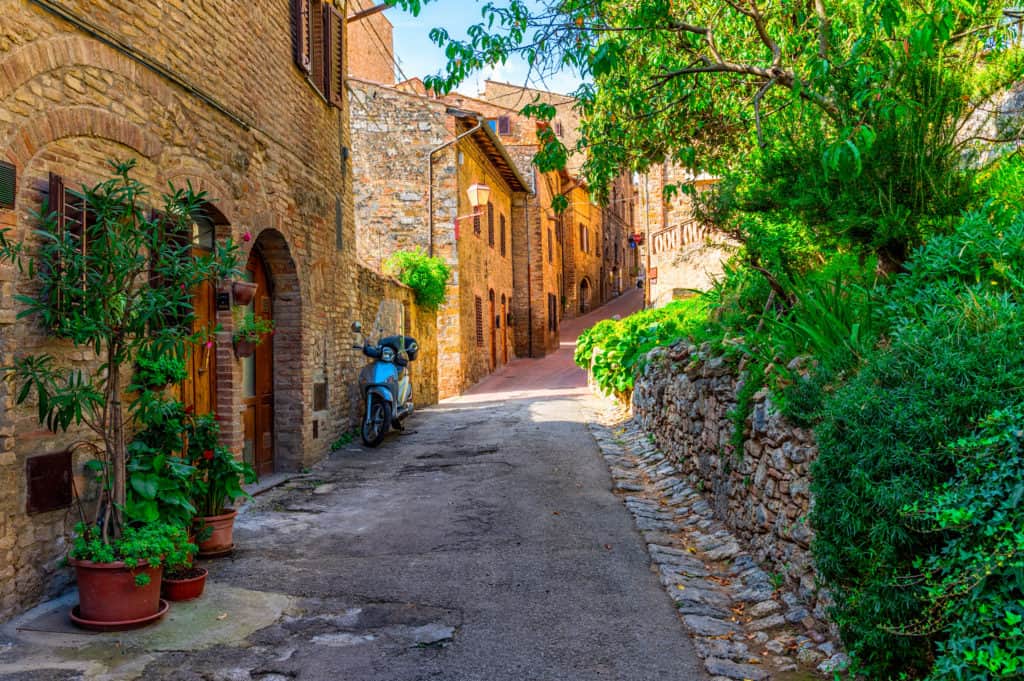
The heaving, sweating, shopping masses of humanity packing the piazzas and dripping gelato on the cobblestones are a distant memory.
So when you visit, get off the main streets and explore the small back streets and alleys, especially atmospheric at night. You’ll have the place to yourself.
Map of San Gimignano
Here’s a map of San Gimignano. It’s a very small and walkable city. You can cross it from gate to gate in about fifteen minutes. Also included on the map are the locations of my three recommended hotels.
How to Get to San Gimignano
San Gimignano is about a 45 minute drive or a two-hour bus ride from Florence. Touring Tuscany by car is probably the best way to see the countryside.
When you arrive, park in one of the parking lots at the base of the town. As you enter San Gimignano, you’ll see electronic signs telling you which parking lots have space. The town is well prepared for the daily onslaught of visitors.
From the parking lots, take the elevator up as far as it goes (not far) and then take the short walk into the historic centre of San Gimignano.
Welcome to the 14th Century
You’re in the 14th century! Your long gown swishes around your legs and you listen for the bells that divide your days and regulate your life.
If you’re a woman, you might be on your way to the baker for a loaf of fresh bread or to the church to make confession. If you’re a man, you could be meeting a kinsman to settle a festering vendetta or to chat with a fellow guild member about the crocus trade.
In the Middle Ages, much of San Gimignano’s wealth came from the cultivation of saffron from the stamens of crocuses. Also lucrative was textile manufacturing and the production of Vernaccia, a lovely white wine still produced today (it’s very good!).
Walk up to the ruined fortezza. There, you’ll enjoy this stunning view of the towers.
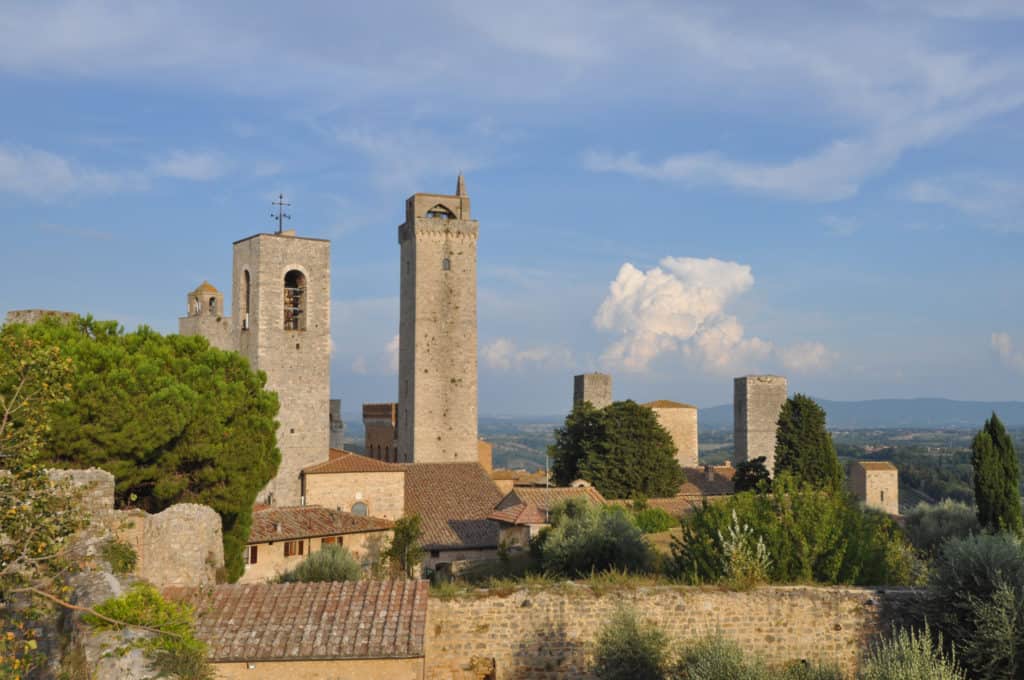
When you walk the back streets of San Gimignano in the 21st century, you’re only an ounce of imagination away from the Middle Ages.
The Towers of San Gimignano
San Gimignano is famous for its towers. In fact, the town is often referred to as the Tuscan city of towers because 14 medieval towers are still standing. In its heyday in the 14th century, over 72 towers dominated its skyline.
But even with only 14 towers, San Gimignano is one of the most beautiful medieval towns in all of Italy.
Why So Many Towers?
Every medieval city had towers back in the day, but San Gimignano is unique because so many of its towers remain.
Why so many towers? We can safely assume that the medieval merchants didn’t build them to give 21st-century tourists something to point their iPhones at.
Wealthy citizens frequently competed with each other to build the tallest towers above their homes. In fact, the Podesta passed a law prohibiting any private citizen from building a tower higher than the Torre Grossa, the municipal hall which survives to this day.
The citizens of San Gimignano were a bellicose lot who sometimes attacked and destroyed towers belonging to their rivals.
The family feuds that form the basis of the Romeo and Juliet story were definitely not fiction. Vendetta and its accompanying violence were all-too-common ways to resolve differences.
History of San Gimignano
The Etruscans first settled San Gimignano in the 4th century BC, but significant growth did not occur until 1000 to 1200. Thanks to its proximity to the Via Francigena, a major route across Italy, San Gimignano was an important stopover for travelers, pilgrims, and merchants.
The town became steadily more prosperous until it declared itself a free Commune in 1199.
In 1300, the poet Dante Alighieri came to San Gimignano, and in 1317 the famous painter Lippo Memmi opened a workshop. With his father, Lippo Memmi painted a fresco cycle in the town hall that you can see today.
I include the frescoes in my post on Art Masterpieces in Tuscany You Don’t Want to Miss and below.
San Gimignano grew and prospered until the mid-14th century. Then, in 1348, the town was devastated by the plague, also known as the Black Death. More than half of the population died in a six-month period.
Following the pestilence that also ravaged most of western Europe, San Gimignano never recovered its former glory and at the end of the 14th century was finally obliged to submit to Florentine rule.
The town’s website provides an excellent overview of San Gimignano’s rise and fall over the centuries. The town is now a UNESCO World Heritage site.
What To See and Do in San Gimignano
San Gimignano’s main attraction is the town itself: the cobbled streets, the towers, and the Tuscan ambience. But you’ll also find several worthwhile attractions to explore, including my favorite, San Gimignano 1300.
San Gimignano Pass
If you’re visiting for more than a day, purchase the San Gimignano Pass, which is the official museum pass of the Tuscan city. You’ll get free admission to municipal museums, the Cathedral of San Gimignano and the Museum of Sacred Art, and the San Lorenzo in Ponte. The pass is valid for 2 days and is stored as a digital ticket on your phone.
San Gimignano 1300
The San Gimignano 1300 (#1) museum contains an amazing scale model of San Gimignano as it appeared in the year 1300 with its 72 towers intact.
Not long after I started my novel, The Towers of Tuscany, about a woman painter in the 14th century, I came across the website for San Gimignano 1300.
I could not believe my luck! Someone had very thoughtfully recreated the entire city in which much of my novel’s action takes place.
I had to see it! A few months after I found San Gimignano 1300 on the web, I was there in person. Few things get in the way of an historical novelist on a research warpath.
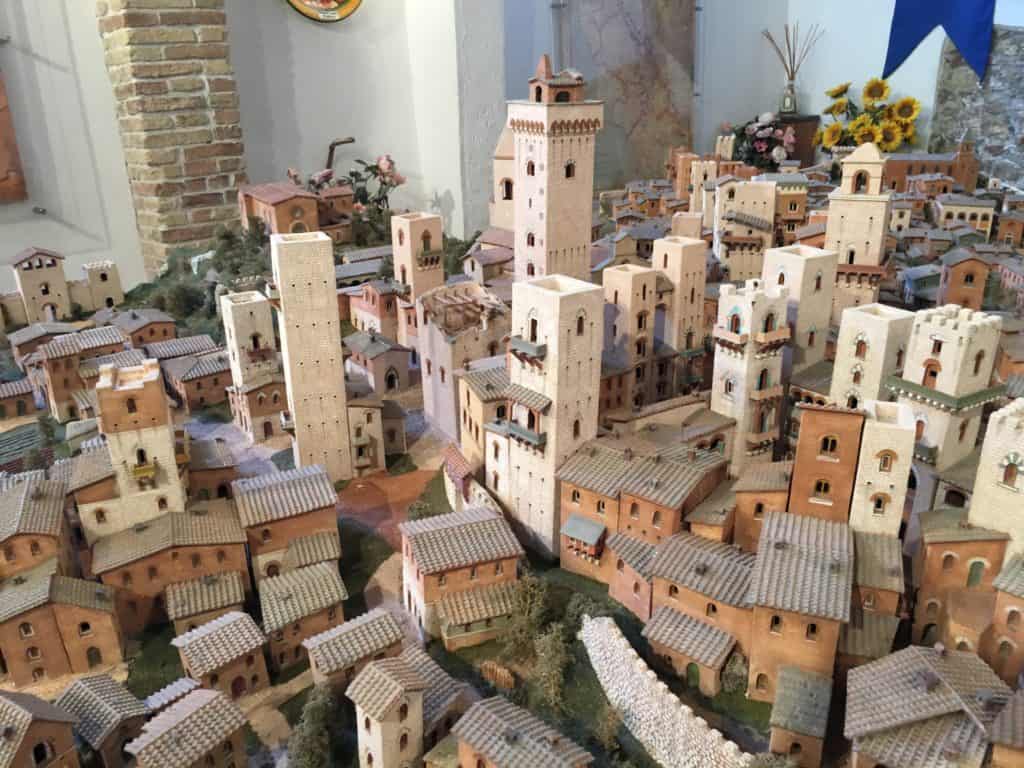
San Gimignano 1300 moved to a smaller venue a few years after I first saw it. The model is now divided into two sections, but you still get a good sense of how the city must have looked in 1300.
The staff at San Gimignano 1300 are lovely. I’ve returned several times in the last few years to replenish their supply of The Towers of Tuscany.
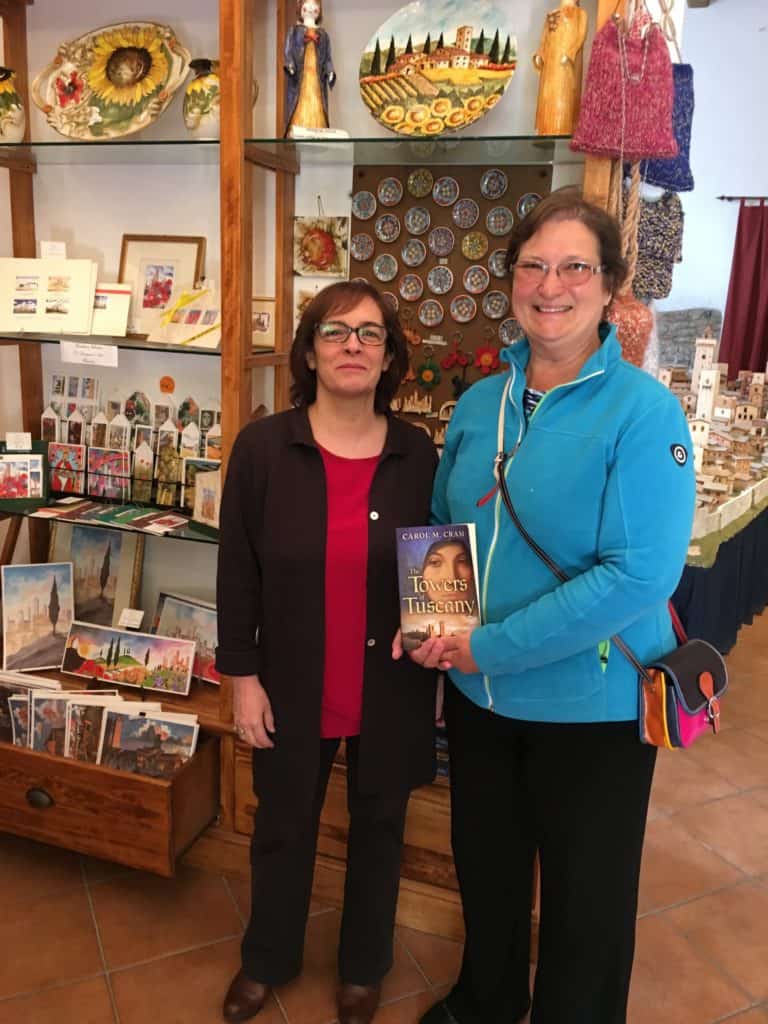
Frescoes, Frescoes, and More Frescoes
Unlike many Italian towns, San Gimignano is stuck in a medieval time warp. Most of the best art was created during the Middle Ages rather than the Renaissance.
I’m a medieval girl at heart and prefer the flatter, more stylized work of the medieval painters to the florid, somewhat over-produced paintings of the Renaissance.
Museo Civico
The first stop for art lovers should be the frescoes in the Museo Civico. Painted by Memmo de Filippuccio and his son Lippo Memmi in 1317, the frescoes portray scenes of everyday life.
Such scenes were a rarity at a time when the vast majority of frescoes and paintings depicted religious subjects.
I like best the two scenes showing a newly married couple first enjoying a communal bath together (ooh la la) and then climbing into bed.
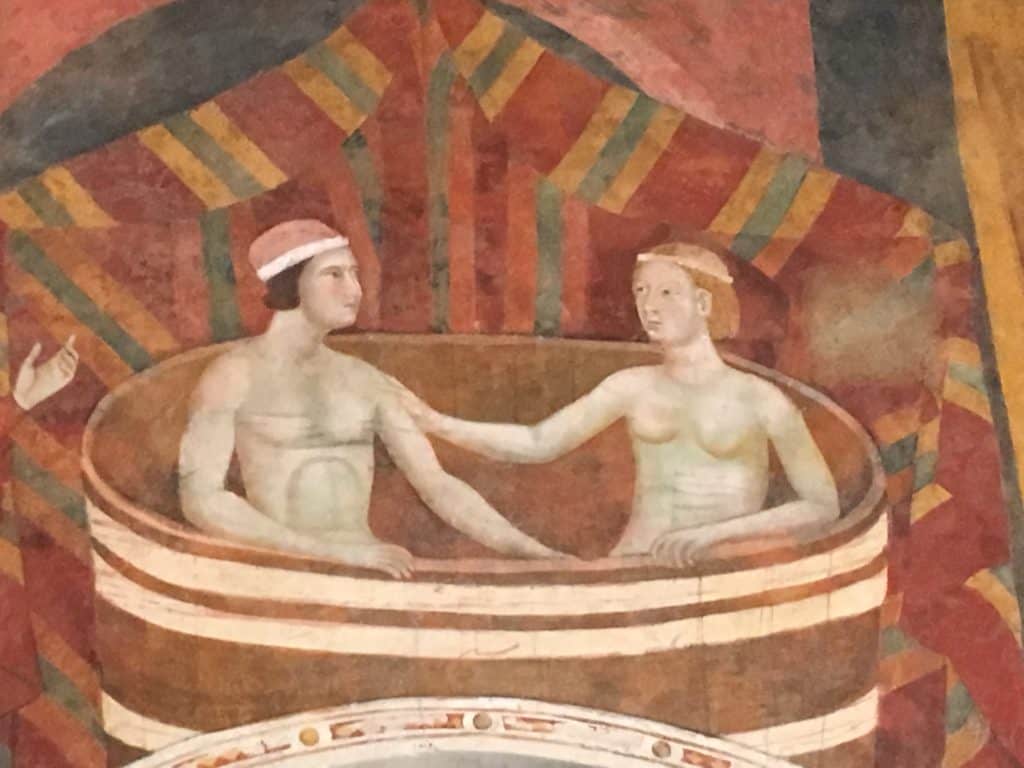
The scene depicting the couple getting into bed shows them as naked. While researching The Towers of Tuscany, I learned that people often slept naked to get a break from the wee beasties that infested their heavy gowns. Also, I imagine that summers in San Gimignano were as hot in the 14th century as they are today.
Tip: Always get a hotel with air conditioning between May and October.
Another fabulous fresco in the Museo Civico is The Maestà by Lippo Memmi. Commissioned in 1317, the fresco is said to have been inspired by Simone Martini’s Maestà from the Palazzo Pubblico in Siena.
The fresco shows Mary seated on a throne surrounded by adoring saints and angels.
Frescoes in the Cathedral of San Gimignano
Other frescoes worth seeing in San Gimignano cover the walls of the cathedral (the Duomo – #2) in the Piazza Duomo in the town center.
One set, painted by Bartolo di Fredi in 1356, depicts scenes from the Old Testament. I particularly like the figure of Noah lying drunk on the ground, his gown open to reveal that he is definitely not wearing his boxer shorts. There’s nothing new under the sun!
Another set of frescoes depicting Hell was painted by Benozzo Gozzoli in 1465. The frescoes are terrifyingly realistic. You might want to avoid them if you’re traveling with children.
Also noteworthy is the Annuniciation by Domenico Ghirlandaio painted in 1482.

Frescoes in Sant’Agostino
The fresco cycle of St. Augustine by Benozzo Gozzoli that covers the walls of Sant’Agostino in a quiet corner of San Gimignano are breathtaking. Here’s one panel depicting St. Augustine teaching in Rome. Check out the sumptuous colors and how the folds of the gowns are depicted.

Torre Grossa
The tallest tower in San Gimignano, at 54 meters (178 feet), is the Torre Grossa (#3), part of the Palazzo Comunale where the Museo Civico is housed.
It’s worth the effort to climb to the top and see the stunning view. If it’s a fine day, go early or late to avoid the crowds.
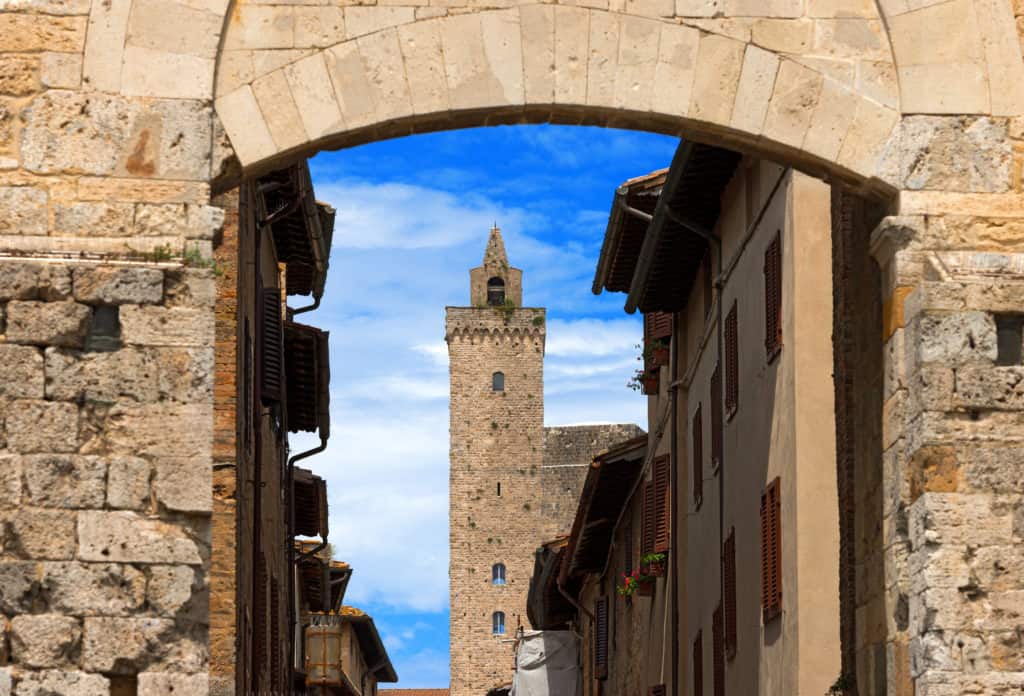
Here’s an option for tickets to the Torre Grossa and the Duomo:
San Gimignano at Night
Ahhhh….! The tour buses have puffed their way down the hill, the shops are shuttered, and peace descends.
Thanks to floodlit towers, the darkness never gets close to the black intensity of the olden days, but your imagination can still get a workout.
You’ll find plenty of good places to eat in San Gimignano. In recent years, the town has become something of a mecca for gourmets. But wherever you decide to eat, make sure you order a glass or two of the delightfully white vernaccia di San Gimignano wine.
Afterwards, walk off the dinner and wine with a stroll through the fast emptying piazzas. The later it gets, the quieter the streets become.
And, unlike in the 14th century, walking the streets of San Gimignano after dark is not dangerous. No assassins are intent on revenging a vendetta; no watchmen are standing by to clamp into irons people who ignore curfews.
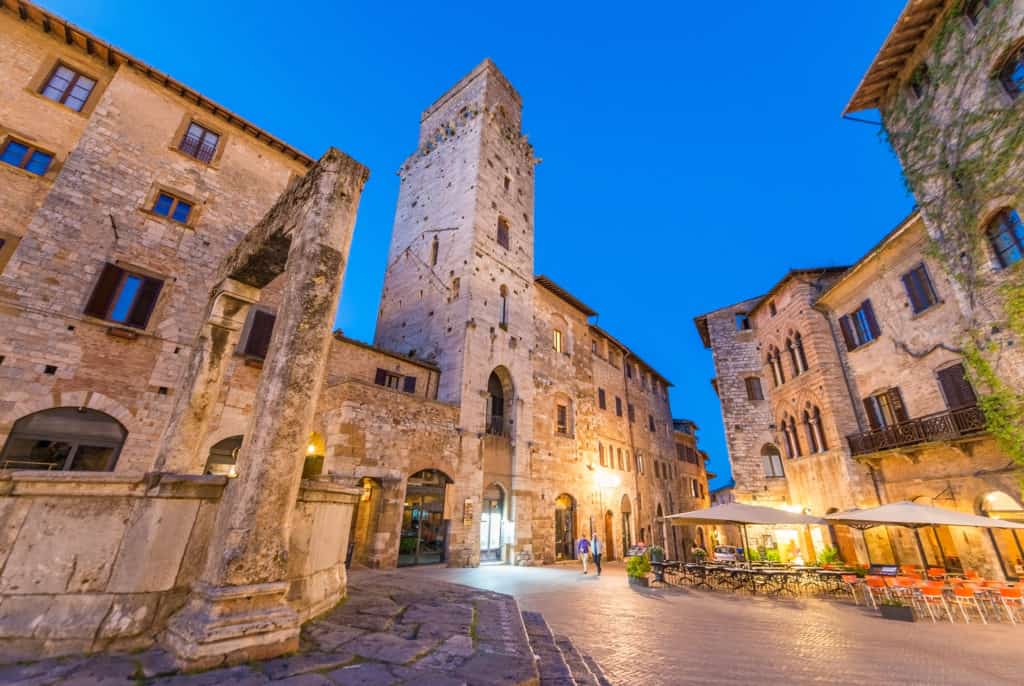
When to Visit San Gimignano
The best times for a visit to San Gimignano are late spring when the surrounding countryside is drenched in the freshest greens imaginable and in September/October when golden light and crisp days make sightseeing a pleasure.
Just remember to take along a rain jacket and a sweater.
One-Day in San Gimignano Itinerary in Brief
Morning – Arrive early, explore Piazza della Cisterna and the frescoes in the Duomo frescoes, and visit San Gimignano 1300
Late Morning – Climb Torre Grossa.
Lunch – Tuscan lunch + Vernaccia tasting.
Afternoon – Visit the Museo Civico to check out the frescoes and then stroll Via San Giovanni and climb up to the Rocca fortress viewpoint.
Late Afternoon – Enjoy a gelato on Piazza della Cisterna and browse the browse artisan shops.
Evening – Take golden-hour photos of the towers, then treat yourself to a gourmet dinner (make reservations) and wander the fast-emptying streets before returning to your hotel
Where to Stay in San Gimignano
In your Tuscany itinerary, allocate at least one night and preferably two nights to staying near San Gimignano. Most bus tours pop in and out for a few hours, staying just long enough for people to sip a cappuccino, climb a tower, and shop.
If you really want to experience this lovely town, stay a while, preferably at one of the lovely hotels in the gorgeous countryside.
Here are three options, all of which I’ve stayed in and can heartily recommend.
- Cappuccina Country Resort is situated north of San Gimignano and commands a wonderful view of the towers from its swimming pool
- Also north of San Gimignano is the lovely Villa Ducci with friendly staff and rooms overlooking the towers.
- Hotel Pescille is on the opposite side of San Gimignano and is my favorite (I’ve stayed there three times). Ask for a room that overlooks the valley with the towers of San Gimignano beyond.
Here are some more options for places to stay in San Gimignano:
Tours to San Gimignano
One way to see San Gimignano if you don’t have a car is on a day trip from Florence. If you’re short on time, then taking a tour that drops you at the gates of this enchanting city is certainly better than not visiting at all! Here’s an option with GetYourGuide that includes Siena and a wine tour.
San Gimignano FAQs
Here are some of the questions I’ve been asked about San Gimignano:
San Gimignano is known for its dramatic skyline of medieval towers, beautifully preserved frescoes in the Museo Civico, the Duomo and Sant’Agostino, and its signature white wine, Vernaccia di San Gimignano. The town’s atmospheric piazzas and sweeping Tuscan views make it one of the region’s most memorable hilltowns.
Absolutely. San Gimignano is one of Tuscany’s most distinctive medieval towns. In just a few hours you can enjoy world-class frescoes, climb the Torre Grossa for panoramic views, wander charming stone streets, and experience authentic local food and wine. It’s best visited as an overnight stop so you can experience the medieval streets at night.
San Gimignano once had 72 family towers, but today 14 survive. These soaring stone structures earned the town its nickname, “The Medieval Manhattan,” and several can be viewed up close from Piazza del Duomo and Piazza della Cisterna.
Yes. San Gimignano is an easy day trip from both Florence and Siena, about 1 hour by car. Buses run from Siena, and Florence offers frequent tours with transportation included. Because parking and crowds increase later in the day, arriving before 10:00 am is ideal. Instead of visiting on a tour, take the bus and check into a hotel in the center of the town. Stay at least one night.
Vernaccia di San Gimignano is a crisp, mineral-driven white wine produced exclusively in the hills surrounding the town. It was Tuscany’s first DOCG wine and is traditionally enjoyed with local cheeses, light pastas, and dishes featuring saffron—another specialty of San Gimignano.
Time for a shameless plug! Very few novels (so far as I know) are set in San Gimignano. The Towers of Tuscany, my first novel (mentioned above) is set in both San Gimignano and Siena. Read it before you visit and then go to San Gimignano 1300.
Conclusion
Have you visited San Gimignano? Share your tips and suggestions for other artsy travelers in the Comments below.
Here are some more posts to give you a taste of Italy or check Visiting Italy to see the full list of posts about Italy.
- Art Masterpieces in Tuscany You Don’t Want to Miss
- Best Itineraries for Exploring Tuscany, Umbria and La Dolce Vita
- Uffizi Gallery: Top 10 Must-See Masterpieces and How to Visit
- Favorite Regions in Italy for the Artsy Traveler
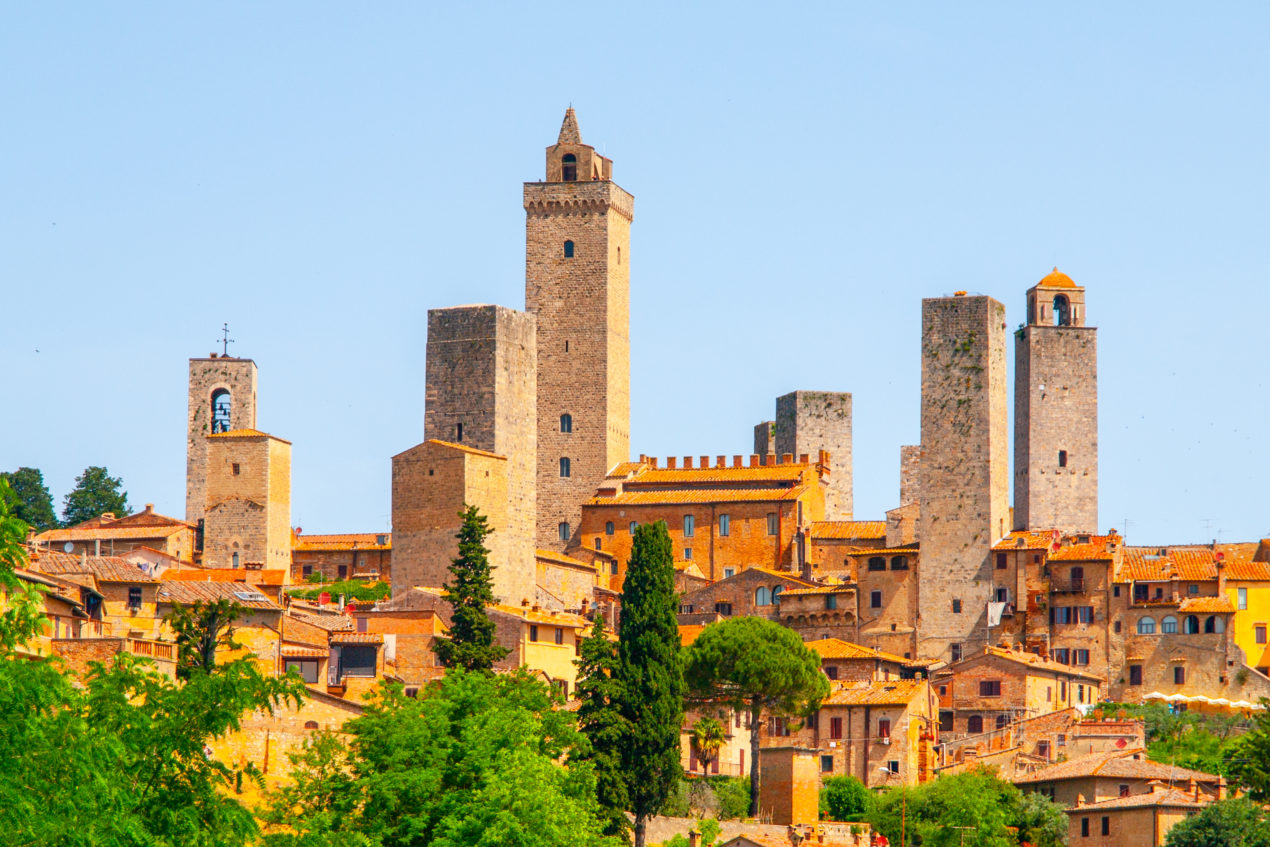
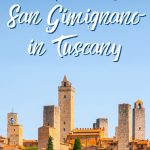
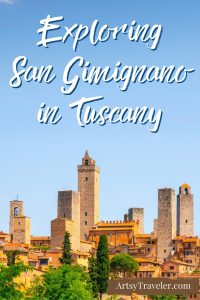
[…] San Gimignano […]
[…] plenty of recommendations and suggestions, read Exploring Tuscany, Umbria and La Dolce Vita and Exploring San Gimignano in Tuscany. Also check out Art Masterpieces in Tuscany Who Don’t Want to […]
[…] For an in-depth look at San Gimignano and why it deserves top billing in your itinerary, read Exploring San Gimignano in Tuscany. […]
[…] us have ever visited Montepulciano and so decided that on this trip we’d skip our usual visits to San Gimignano and Siena and see something new. Good […]